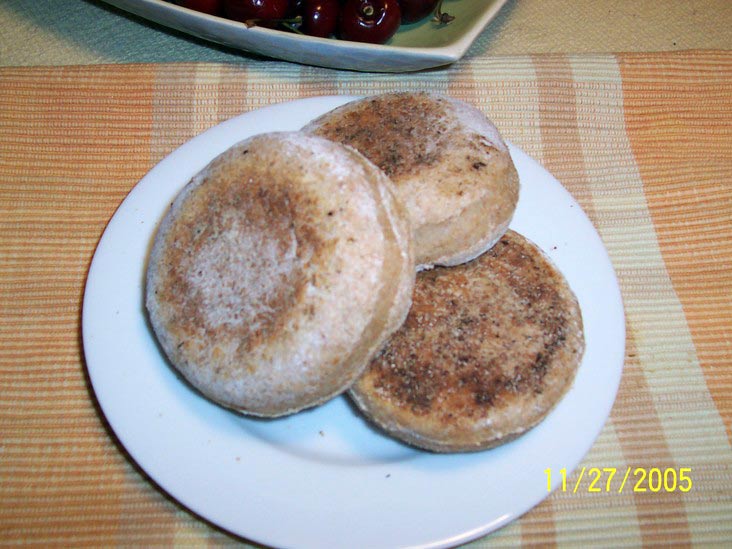Formula - Japanese Style White Sandwich Bread - Water Roux Starter / Sponge





http://www.flickr.com/photos/49353374@N06/sets/72157623866998940/show/
| | | | | | |
| | | | | | |
| From 'The 65 C Bread Doctor" by Yvonne Chen | | | | |
| | | | | | |
| | | | | | |
| Water Roux Starter | | | | | |
| | | | | | |
| any amount is fine | bread flour | 50 | g | | |
| as long as the 1:5 ratio is followed | water | 250 | g | | |
| | | | | | |
| | Whisk both until well mixed | | | | |
| | Heat it up on stove, keep stirring | | | | |
| | until temperature reaches 65 C or 149 F | | | | |
| | (Yippee uses the microwave, about 4 minutes, stir halfway.) | | |
| | (Final product should leave a trail when stirred.) | | | |
| | Put a plastic wrap directly on top to prevent forming a 'skin'. | | |
| | Must be cooled to at least room temperature before use. | | |
| | Refrigerate up to 3 days. | | | | |
| | Do not use if turns grey. | | | | |
| | | | | | |
| | | | | | |
| Makes 2 loaves | | | | | |
| Original recipe uses water roux starter only, sponge not necessary. | | | | |
| Yippee threw in an additional step of developing the sponge out of the total, see side column for her portions. | | |
| | | | | | |
| | | | | | Yippee's Sponge |
| A. | bread flour | 540 | g | | 400 |
| | sugar | 86 | g | | |
| | salt | 8 | g | | |
| | yeast | 11 | g | | 8 |
| B. | whole eggs | 86 | g | | 86 |
| | whipping cream (can substitute with either half n half or milk) | 59 | g | | 59 |
| | milk | 54 | g | | 54 |
| | milk (recipe calls for flavor enhancer but Yippee uses milk instead) | 9 | g | | 9 |
| | | | | | |
| | water roux starter | 144 | g | | 2 TBSP out of the 144g |
| C. | butter | 49 | g | | |
| | | | | | |
| Mix: | Combine A. and B. until a ball is formed. | | | | |
| | Add C. and knead until the dough passes the windowpane test. | | |
| | (Yippee says: use your judgment, each machine is different) | | |
| | (Yippee kneads her dough in her Zojirushi breadmaker for 30 minutes. | |
| | | | | | |
| 1st Fermentation: | About 40 minutes at 28 C or 82.4 F, 75% humidity | | |
| | | | | | |
| Scale: | into 4 pieces if making twin loaves, each at 265g | | | |
| | (Yippee makes 2 log loaves, each at 530g) | | | | |
| Rest: | | | | | |
| | 15 minutes at room temperature | | | | |
| | | | | | |
| Shape: | For twin loaves: | | | | |
| | Degas | | | | |
| | Roll into an oval | | | | |
| | With the long side facing you: | | | | |
| | Fold 1/3 from top to bottom, press to seal | | | | |
| | Fold 1/3 from bottom to top, press to seal | | | | |
| | Turn seam side down | | | | |
| | Roll and elongate the dough to about 30cm or 12 " | | |
| | Upside down and roll into a cylindrical shape | | | |
| | Seam side down, into the loaf pan | | | | |
| | | | | | |
| | For log loaves: | | | | |
| | Shape like regular sandwich bread | | | | |
| | | | | | |
| Final Proof: | About 40 minutes at 38 C or 100.4 F, 85% humidity | | |
| | (Yippee lets the dough rise for 20 more minutes to get a taller loaf) | | |
| | | | | | |
| Bake: | Whole egg wash, no water added | | | | |
| | 350 F, 35-40 minutes | | | | |
Sponge preparation:
a. Use the ingredients listed on the side column, mixed until all are well incorporated
b. Leave at room temperature ~ 76-80F for an hour
c. Grease a food grade plastic bag, pour dough in, leave enough space to allow the dough to expand to about 160% of its size, reinforce the bag with double or triple bagging before tightening it, retard overnight
d. Subtract the above ingredients from the main formula, whatever remaining will be mixed at the 'Mix' stage with the sponge. Follow the rest of the formula.
However, if your dough feels cold after mixing due to the refrigerated sponge, instead of following the time suggested in the formula, watch your dough:
1st Fermentation: Completes when the dough has risen to about 180% of its size
Final Proof: Completes when a dent is formed and very slowly bounces back
when dough is poked with a floured finger
To make rolls:
Scale: 60g each
Bake: 350F, about 15 minutes
rest of the procedures unchanged
Choice of fillings, if preferred: bacon, roast chicken, cheese, red bean, pork, curry and custard cream.
Pictures of assorted buns I made before:
http://www.flickr.com/photos/33569048@N05/sets/72157617619002761/show












